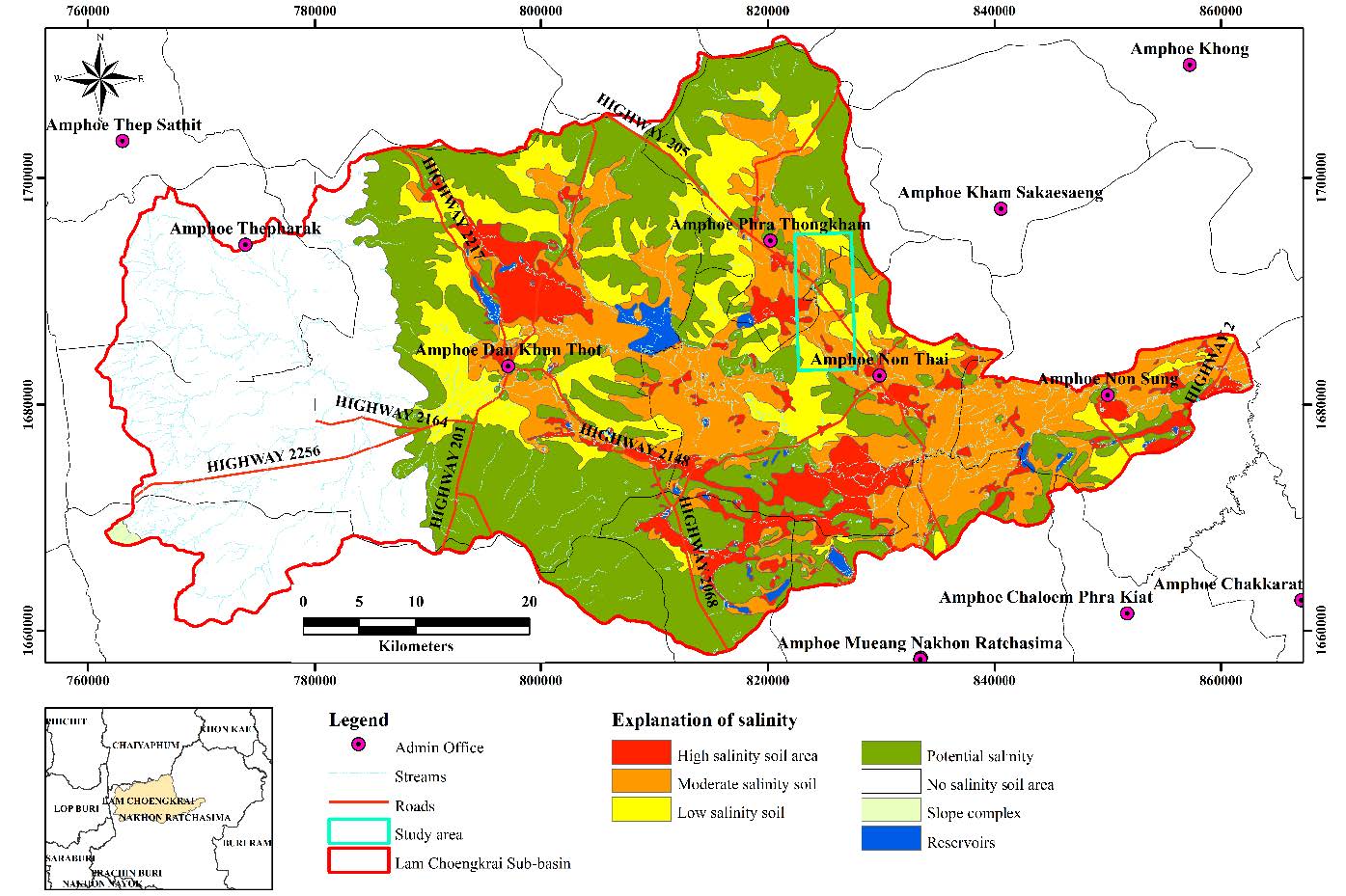Distribution of Salinity in Surface Water Surrounding Salt Mines in Non Thai and Phra Thong Kham Districts, Nakhon Ratchasima Province, Thailand 10.32526/ennrj/22/20240042
Main Article Content
Abstract
Nakhon Ratchasima Province faces significant challenges due to saline soil and water, resulting from natural salt rock deposits and salt mining activities. This study investigates the physicochemical properties, salinity distribution, and surface water quality in Non Thai and Phra Thong Kham District. A total of 75 samples were collected, with 48 from Non Thai and 27 from Phra Thong Kham. The analysis focused on properties such as temperature, electrical conductivity (EC), pH, total dissolved solids (TDS), salinity, chloride, sodium, calcium, and magnesium. Water quality was assessed using standards from the Thai Department of Health and the World Health Organization. Additionally, the Sodium Adsorption Ratio (SAR) was employed to evaluate irrigation suitability, and ArcGIS 10.5 was utilized to map salinity and water quality distribution. Results indicated that surface water pH remained relatively neutral and within acceptable limits. However, salinity levels varied from 0.5 to 30 ppt, indicating brackish to saline conditions. In several areas, concentrations of salinity, sodium, and chloride exceeded standard limits. Factors such as proximity to salt mines, water flow direction, lower terrain, and smaller reservoirs were linked to increased salinity, with Phang Thiam Subdistrict in Phra Thong Kham District showing the highest levels. The SAR index further indicated that water quality in Phra Thong Kham was unsuitable for domestic use and irrigation, unlike Non Thai. Further research in other salt mine areas are essential for a deeper understanding of salinity distribution, which is crucial for assessing risks and making informed decisions to protect public health and the environment.
Article Details

This work is licensed under a Creative Commons Attribution-NonCommercial 4.0 International License.
Published articles are under the copyright of the Environment and Natural Resources Journal effective when the article is accepted for publication thus granting Environment and Natural Resources Journal all rights for the work so that both parties may be protected from the consequences of unauthorized use. Partially or totally publication of an article elsewhere is possible only after the consent from the editors.
References
Akhrajanthachot B. Potash and salt mine in the North-Eastern of Thailand. Proceedings of the Thai-Lao Technical Conference on Geology and Mineral Resources; 2010 Sep 7-8; Bangkok, Thailand: Rama Gardens Hotel; 2010.
Department of Health (DoH). Notification of the Department of Health on Criteria for Recommendation of Drinking Water Quality Surveillance, B.E. 2563 (A.D. 2020). Thailand: Ministry of Public Health; 2020 (in Thai).
Department of Primary Industries and Mines (DPIM). General mining concession information [Internet]. 2009 [cited 2024 Jan 10]. Available from: https://www1.dpim.go.th/mne /mn.php?nox=&pltname=&status=*&ore1=&ore2=&prov=30&b1dx=00&b1mx=00&b1yx=0000&b2dx=00&b2mx=00&b2yx=0000&a1dx=00&a1mx=00&a1yx=0000&a2dx=00&a2mx=00&a2yx=0000. (in Thai).
Department of Primary Industries and Mines (DPIM). Study of saline soil in the Nakhon Ratchasima salt production area [Internet]. 2010 [cited 2024 Jan 10]. Available from: https://envi-mining.dpim.go.th/modules.php?m=article&op =detailnewsupdate&NUID=19. (in Thai).
El Tabakh M, Utha-Aroon C, Schreiber BC. Sedimentology of the cretaceous Maha Sarakham evaporites in the Khorat Plateau of northeastern Thailand. Sedimentary Geology 1999;123:31-62.
Environment and Pollution Control. Report Summarizing Water Quality Results Surface Water Resources, 4th Quarter, Fiscal Year 2022. Nakhon Ratchasima. Thailand: Pollution Control Department, Ministry of Natural Resources and Environment; 2022 (in Thai).
Green News. Revealing the cause of heavy saltwater spread “Khorat mine dug into the water source - will continue. Must make a new EIA” [Internet]. 2022 [cited 2024 Jan 24]. Available from: https://greennews.agency/?p=32079. (in Thai).
Guettaf M, Maoui A, Ihdene Z. Assessment of water quality: A case study of the Seybouse River (North East of Algeria). Applied Water Science 2017;7:295-307.
Land Development Department. Appropriate Agricultural Promotion Guidelines Nakhon Ratchasima Province. Thailand: Land Development Department, Ministry of Agriculture and Cooperatives; 2021.
LEO EnviroSci Inquiry. Lehigh University. Chloride and Salinity [Internet]. 2011 [cited 2024 Jan 29]. Available from: https://ei.lehigh.edu/envirosci/watershed/wq/wqbackground/chloridebg.html.
Lesch SM, Suarez DL. A short note on calculating the adjusted SAR index. Transaction of American Society of Agricultural and Biological Engineers 2009;52(2):493-6.
Local Information Center for Development (LICD). Basic Information of Nakhon Ratchasima Province. “General geography of Non Thai and Phra Thong Kham Districts”. Nakhon Ratchasima, Thailand: Local Information Center for Development of Nakhon Ratchasima; 2022 (in Thai).
Phoemphon W, Terakulsatit B. Assessment of groundwater potential zones and mapping using GIS/RS techniques and analytic hierarchy process: A case study on saline soil area, Nakhon Ratchasima, Thailand. AIMS Geosciences 2022; 9(1):49-67.
Prachathai News. “Villagers demand a solution to the problems affecting the Dan Khun Thot” [Internet]. 2023 [cited 2024 Jan 24]. Available from: https://prachatai.com/journal/2023/ 12/107123. (in Thai).
Royal Irrigation Department. Developing Water Resources to Solve Drought and Flood Problems in the Lam Chiang Krai Basin 2019. Nakhon Ratchasima, Thailand: Thailand Ministry of Agriculture and Cooperatives; 2020 (in Thai).
Skoog DA, West DM, Holler FJ. Fundamentals of Analytical Chemistry. 7th ed. USA: Thomson Learning, Inc; 1996.
Suwanich P. Potash and rock salt in Thailand. In: Nonmetallic Minerals Bulletin No.2. Bangkok, Thailand: Economic Geology Division, Department of Mineral Resources; 1986.
Thongwat W. Relationship between Soil Salinity and Chloride Content in Groundwater in Saline Soil Areas of Nakhon Ratchasima Province [dissertation]. Nakhon Ratchasima: Suranaree University of Technology; 2018.
Thongwat W, Terakulsatit B. Using GIS and map data for the analysis of the relationship between soil and groundwater quality at saline soil area of Kham Sakaesaeng District, Nakhon Ratchasima, Thailand. International Journal of Materials and Metallurgical Engineering 2019;13(1):32-9.
Utha-aroon C. Continental origin of the Maha Sarakham evaporates Northeastern Thailand. Journal of Southeast Asian Earth Sciences 1993;8(1-4):193-203.
Wannakomol A. Soil and Groundwater Salinization Problem in the Khorat Plateau, Northeast Thailand [dissertation]. Berlin, Germany: Freie University; 2005.
Wannakomol A, Terakulsatit B. Study and the land subsidence risk level mapping in the rock salt production area of Nakhon Ratchasima Province by using Synthetic Aperture Radar and Geophysical Data. Nakhon Ratchasima, Thailand: Suranaree University of Technology; 2018.
World Health Organization (WHO). World Health Organization’s (WHO) Guidelines for Drinking-Water Quality. 4th ed. Geneva, Switzerland: World Health Organization; 2022.

